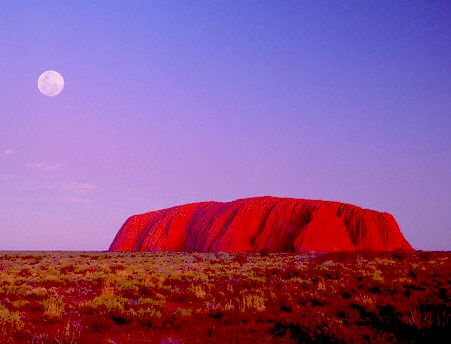AUSTRALIA'S AYERS ROCK

AYERS ROCK IS ONE OF THE OLDEST SANDSTONE FORMATIONS ON EARTH
Uluru, also known as Ayers Rock, is a large sandstone rock formation in central Australia, in the Northern Territory. It is located in Uluru-Kata Tjura National Park, 440 km southwest of Alice Springs. Uluru is sacred to the Pitjantjatjara and Yankunytjatjara, the Aboriginal people of the area. It has many springs, waterholes, rock caves and ancient paintings. Uluru is listed as a World Heritage Site for its natural and man-made attributes. In October 1872 the explorer Ernest Giles was the first non-indigenous person to sight the rock formation. He saw it from a considerable distance, and was prevented by Lake Amadeus from approaching closer. He described it as “the remarkable pebbleâ€. On 19 July 1873, the surveyor William Gosse visited the rock and named it Ayers Rock in honor of the then Chief Secretary of South Australia, Sir Henry Ayers. The Aboriginal name was first recorded by the Wills expedition in 1903. Since then, both names have been used, although Ayers Rock was the most common name used by outsiders until recently. In 1993, a dual naming policy was adopted that allowed official names that consist of both the traditional Aboriginal name and the English name. “Uluru/Ayers Rock†became the first officially dual named feature in the Northern Territory.
 PITJANTJATJARA ABORIGINE AT ULURU/AYERS ROCK
PITJANTJATJARA ABORIGINE AT ULURU/AYERS ROCKThe beginning of human settlement in the Uluru region has not been determined, but archaeological findings to the east and west indicate a date more than 10,000 years ago. On 26 October 1985, the Australian government returned ownership of Uluru to the local Pitjantjatjara Aborigines. Around Mount Uluru there are many examples of ancestral sites. The Anangu explanations of these sites and of the formation of Mount Uluru itself derive from the Tjukurpa. Most of these explanations are in the realm of secret information and are not disclosed to Piranypa, the non-Aborigines. In order to understand the religion of the Aborigines, one must have a basic understanding of the organization of the tribes. All men and women belong to small groups, called clans. Each clan posses a distinct body of spiritual properties, or sacred sites and has a totem. Totemism is a view of nature and life, of the universe and man, which colors and influences the Aborigines' social groupings and mythologies, inspires their rituals and links them to the past. It unites them with nature's activities and species in a bond of mutual life-giving, and imparts confidence amidst the vicissitudes of life.
 Ikari Cave on the eastern face of Uluru: The wagtailwoman
Ikari Cave on the eastern face of Uluru: The wagtailwomanTjintirtjintirpa was in this cave when she heard the sounds of ceremony,
sounds that made her laugh. This laugh was later carved out of Uluru
in the shape of a mouth; Ikari is the Anangu word for mouth.
~~~~~~~~~~~~~~~~~~~~~~~~~~~~~~~~~~~~~~~~~~~~~~~~~~~~
We recently viewed AUSTRALIA the movie, it was excellent! Learning about this Culture, from the child's Story...
AUSTRALIA:: Now Available on Blu-ray & DVD
Official site including photos, trailers, and release dates.
www.australiamovie.com/


